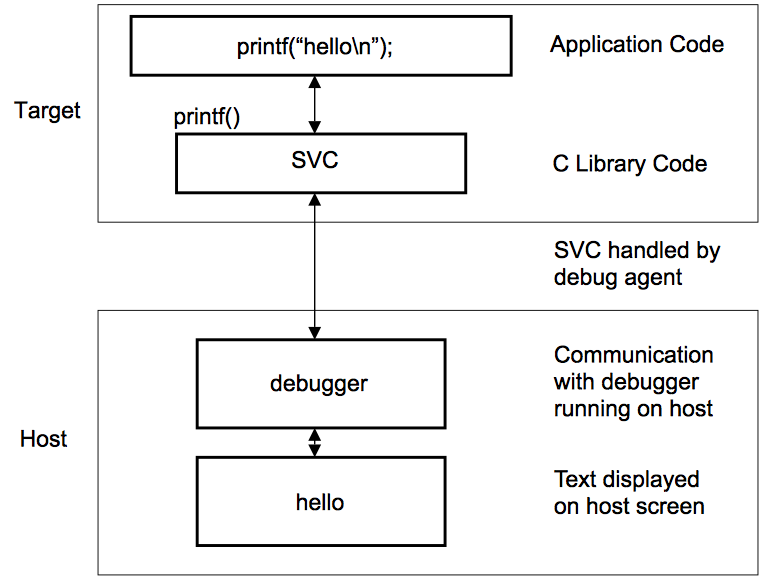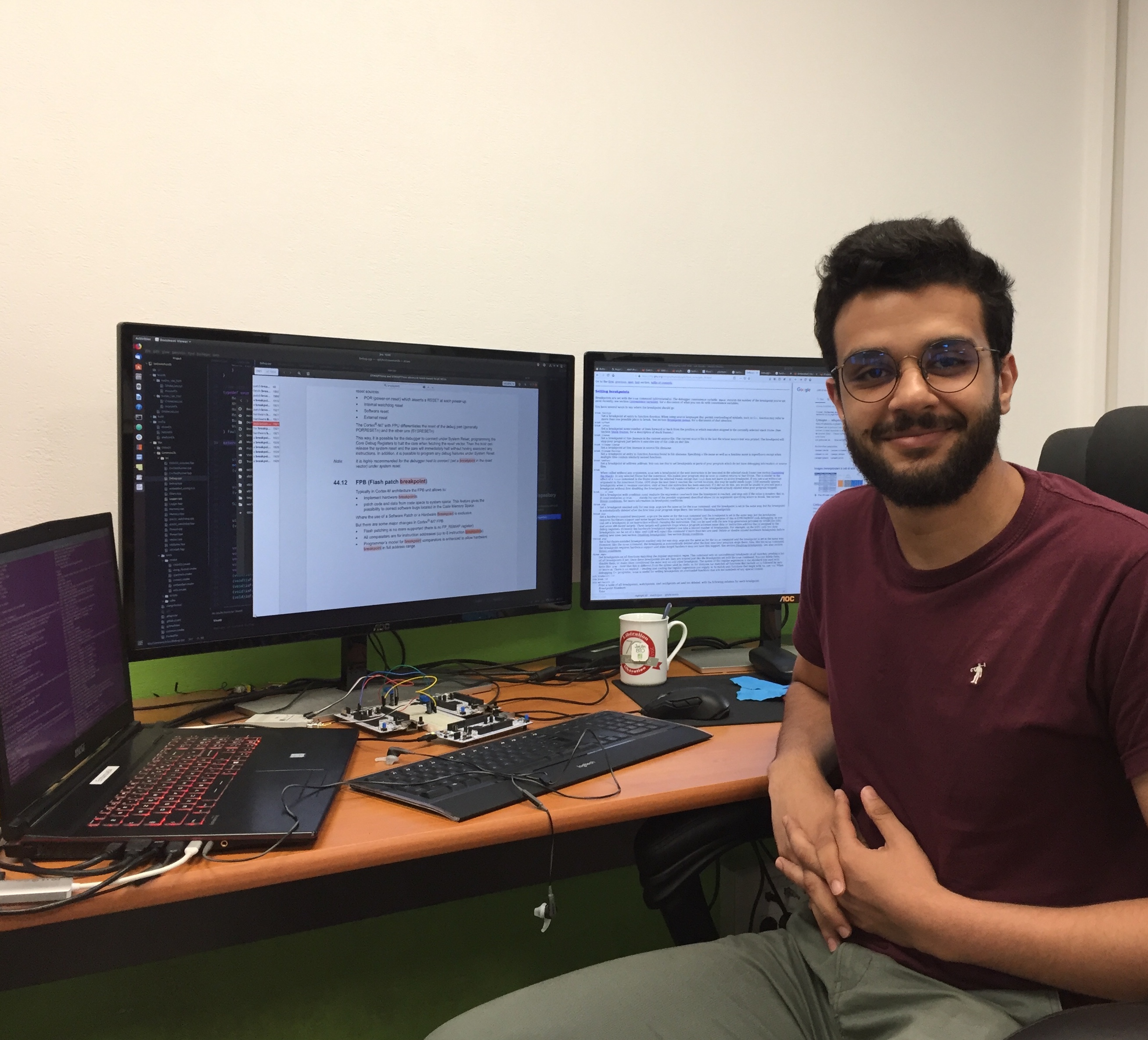Introduction to ARM Semihosting
Firmware developers are generally accustomed to using logging for execution information. On microcontrollers, this is usually done through a serial interface attached to a terminal on the host.
But one might need more advanced features from the host! I was in this position not long ago 🤨.
When working on camera firmware, and particularly on the image processing algorithm, I constantly needed to transfer images from the camera to my host machine to make sure everything was working fine. So I started using semi-hosting! It has greatly facilitated not only my development but also the debugging of my embedded software.
Semihosting is one of the many interesting features available on ARM Cortex microcontrollers. It allows an embedded program to take advantage of the capabilities of an attached computer when the debugger is running.
This post introduces semihosting and shows how to use it and integrate it into your own embedded projects.
Table of Contents
What Is Semihosting
According to ARM documentation1, semihosting is a mechanism that enables code running on an ARM target to communicate and use the Input/Output facilities on a host computer that is running a debugger.
In other words, an ARM based MCU can run C library functions, such as
printf(), scanf, or even fopen, and have these interact directly with the
host computer attached to the device. By doing so, it can benefit from the
screen, the keyboard, or the disk of the host.

How It Works
This is done by halting the CPU target by the debugger agent, either by running
into a breakpoint instruction (BKPT 0xAB for ARMv6-M or ARMv7-M) or by
sending a supervisor call instruction (SVC 0xAB or SVC 0x123456) depending
on the target architecture or processor.
This indicates to the host that the target is requesting a semihosting operation.
The debugger agent then figures out the operation requested by the target by
reading the content of r0, and, if necessary, accesses all other function
parameters pointed by r1.
While the CPU is still halted, the host will execute the requested operation and
return the result in r0 before allowing the processor to continue running its
program.
The following is a list of the semihosting operations defined by ARM2:
/* File operations */
SYS_OPEN EQU 0x01 //Open a file or stream on the host system.
SYS_ISTTY EQU 0x09 //Check whether a file handle is associated with a file or a stream/terminal such as stdout.
SYS_WRITE EQU 0x05 //Write to a file or stream.
SYS_READ EQU 0x06 //Read from a file at the current cursor position.
SYS_CLOSE EQU 0x02 //Closes a file on the host which has been opened by SYS_OPEN.
SYS_FLEN EQU 0x0C //Get the length of a file.
SYS_SEEK EQU 0x0A //Set the file cursor to a given position in a file.
SYS_TMPNAM EQU 0x0D //Get a temporary absolute file path to create a temporary file.
SYS_REMOVE EQU 0x0E //Remove a file on the host system. Possibly insecure!
SYS_RENAME EQU 0x0F //Rename a file on the host system. Possibly insecure!
/* Terminal I/O operations */
SYS_WRITEC EQU 0x03 //Write one character to the debug terminal.
SYS_WRITE0 EQU 0x04 //Write a 0-terminated string to the debug terminal.
SYS_READC EQU 0x07 //Read one character from the debug terminal.
/* Time operations */
SYS_CLOCK EQU 0x10
SYS_ELAPSED EQU 0x30
SYS_TICKFREQ EQU 0x31
SYS_TIME EQU 0x11
/* System/Misc. operations */
SYS_ERRNO EQU 0x13 //Returns the value of the C library errno variable that is associated with the semihosting implementation.
SYS_GET_CMDLINE EQU 0x15 //Get commandline parameters for the application to run with (argc and argv for main())
SYS_HEAPINFO EQU 0x16
SYS_ISERROR EQU 0x08
SYS_SYSTEM EQU 0x12
How to Use It
In this example, I run the program on an STM32 and use the arm-none-eabi
toolchain along with openOCD gdbserver. Other tools may be used instead
depending on your hardware, for more details on which debug interface to use, it
would be wise to read this article.
Once you are all set, we can start coding.
First, to enable semihosting, you need to link:
-
libc.a, the standard C library (newlib3 forarm-none-eabi-gcc), - and
librdimon.a, a part of the libgloss4 library (for platform-specific code) to your project.
This is done by adding a few options to the ARM linker:
- removing
-nostartfilesflag to allow linking standards libraries, - adding
-lc -lrdimonflags, - and changing the spec strings file5 to
--specs=rdimon.specsto use the semihosted version of the syscalls.
The last point essentially means that the system calls can be used when a debugger is attached (note that the CPU may crash if a debugger is not present).
Now on the C code side, you need to call initialise_monitor_handles() before
starting a semihosting operation.
#ifdef SEMIHOSTING
extern void initialise_monitor_handles(void);
#endif
int main(void) {
#ifdef SEMIHOSTING
initialise_monitor_handles();
#endif
// other tasks ...
#ifdef SEMIHOSTING
printf("hello world!\n");
printf("hello world!\n");
#endif
// other tasks ...
return 0;
}
If you are using crt0 initialization function, initialise_monitor_handles()
has already been called for you before main().
Once you have done this, you can compile and program your microcontroller as usual, however, once the microcontroller flashed it should be halted and not run yet.
In my case, I launch OpenOCD gdbserver in one terminal, to flash, reset and
halt the CPU. And run gdb from another terminal to connect to the server, and
enable the semihosting in the server side6.
$ arm-none-eabi-gdb -ex "target extended-remote localhost:3333" -ex "monitor reset halt" -ex "monitor arm semihosting enable"
If
initialise_monitor_handles()is called before enabling the semihosting in the server, aHardFaultmay occur due to an unexpected debug event.
Once semihosting is enabled, you can run your program from gdb, and the
semihosting operation will be handled by the gdbserver.
Isn’t it great? 😋
Conclusion
I hope it was fun reading this post, semihosting is not commonly used in embedded development because it slows down the execution speed, but nevertheless, it can be very handy in some cases.
I look forward to your remarks, tips, and comments.
See anything you'd like to change? Submit a pull request or open an issue on our GitHub

